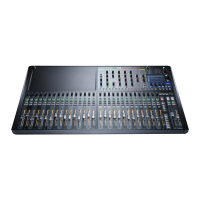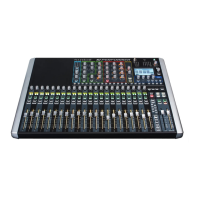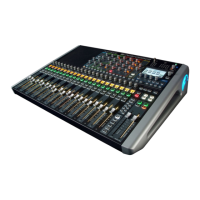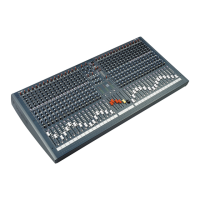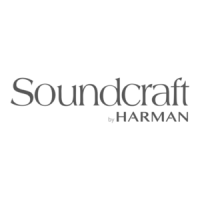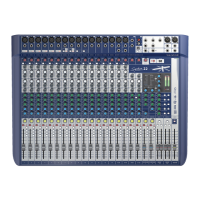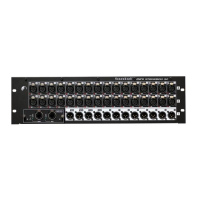Do you have a question about the SoundCraft Si EXPRESSION and is the answer not in the manual?
Essential safety instructions and important symbols to be aware of before using the mixer.
Details the terms and conditions of the product warranty, including coverage and exclusions.
Provides detailed technical data and performance characteristics of the Si Expression console.
Provides an overview of the console's features, assignable controls, and main sections.
Identifies and describes the physical components and connectors of the Si Expression console.
Explains the FaderGlow™ feature for user status indication and error reduction on console faders.
Details the four main fader layers and how they are assigned to control different console functions.
Explains the role of control channels in managing DSP channels and their assignment to the ACS.
Describes how to switch console encoders globally between GAIN/TRIM, FILT (HPF), and PAN functions.
Details how to use the ACS to control all input, EQ, dynamics, and output functions of a selected channel.
Explains the tOTEM system for rapid access to bus contributions and assigning bus control to faders.
Explains how to access and navigate the main menu structure of the console's touch screen.
Details access to System, Prefs, Insert, and Solo settings via the Touch Screen Main Menu.
Describes how to access Oscillator and Monitor settings through the Touch Screen Main Menu.
Covers the console's flexible patching system for inputs and outputs, including Auto Complete.
Explains the D.O.G.S. system for maintaining gain structure between channel input and direct output.
Details controlling BSS Soundweb London devices' preamp controls via Harman's HiQnet protocol.
Outlines the default patching configurations for Expression consoles across different models.
Describes the ViSi Connect card slot for expanding inputs and outputs with various modules.
Details connecting Soundcraft Mini and Compact Stageboxes via MADI card for expanded I/O.
Explains input channel types (mono, stereo, linked) and their contributions to busses and FX sends.
Details settings for input channels: naming, isolate, type, direct output pre/post, and patching.
Describes Mix Bus Masters (MIX 1-14), their uses, contributions, and available output-specific options.
Explains Matrix Busses and Masters, their uses, contributions, and available output-specific options.
Describes the Main L/R and Mono/Centre busses, their inputs, and available output options.
Explains the role of FX Send busses (FX 1-4) in feeding the internal Lexicon FX units.
Allows pinpoint adjustment of controls by detailing values and alternate units on the touch screen.
Details the controls within the ACS, broken down into small color-coded sections for clarity.
Covers input features like phantom power, mic/line level, metering, and HPF for input channels.
Explains the threshold-driven gain reduction process and sidechain filter settings of the gate.
Details the compressor's threshold-driven gain reduction and make-up gain for dynamic range control.
Describes the four-band EQ with shelving and parametric filters for sculpting the signal's tonal balance.
Covers output features like Delay, Pan, and LR/Mono routing applicable to various channel types.
Explains encoder functions (Gain, Filter, Pan) and key controls on the console's control channels.
Details the 28-band Graphic EQs available on output masters and how to assign them to faders.
Guides on setting up and using up to four mute groups with the Mute Group Master buttons.
Explains how to copy and paste processing sections, FX settings, and mixes between channels/busses.
Allows checking and changing switch status across channels on the selected fader layer.
Details PFL/AFL soloing, auto solo modes, highlight, blend, and Solo In Place functionality.
Covers monitoring sources, headphone output level control, and monitor output patching.
Explains CLR and ALT+CLR functions for clearing/resetting parameters, channels, and bus mixes.
Details creating, deleting, loading, and saving show files, including console configuration resets.
Explains the Cuelist and snapshot system for preset console states and automation.
Details editing cue names, MIDI transmit/receive, and HiQnet automation parameters.
Explains how input channels contribute to FX busses and how FX returns are routed.
Describes Hall, Plate, Chamber, Room, Ambience, and Spring reverb effect types.
Details adjustments for Pre Delay, Reverb Time, ER Level/Time, Size, and High Cut.
Describes Studio, 2-Tap, Modulated, Mono, Pong, Tape, and Reverse delay effect types.
Details adjustments for Delay Time, Feedback, Hi Pass, Lo Pass, and Ducking parameters.
Describes Chorus, Flanger, Phaser, Tremolo, Vibrato, Rotary, Pitch Shift, and Detune effects.
Details parameters for Speed, Depth, Voices, Regeneration, Diffusion, and Pre Delay.
Covers LED/LCD brightness, FaderGlow brightness, and D.O.G.S. system enable/disable.
Provides console info, network settings, and functions for resetting channels, busses, and patching.
Details setting access privileges, creating users, and locking console functions.
Step-by-step guide for updating the Si Expression console software via USB.
Procedure to restore factory defaults and re-format the internal SD card, warning about data loss.
Verifying solo status, channel patches, meters, and phase to diagnose signal path issues.
Troubleshooting gate status, insert returns, channel mute/ON status, fader, and pan positions.
Ensuring signal is routed to valid outputs and checking output master channel path and patch.
Essential safety instructions and important symbols to be aware of before using the mixer.
Details the terms and conditions of the product warranty, including coverage and exclusions.
Provides detailed technical data and performance characteristics of the Si Expression console.
Provides an overview of the console's features, assignable controls, and main sections.
Identifies and describes the physical components and connectors of the Si Expression console.
Explains the FaderGlow™ feature for user status indication and error reduction on console faders.
Details the four main fader layers and how they are assigned to control different console functions.
Explains the role of control channels in managing DSP channels and their assignment to the ACS.
Describes how to switch console encoders globally between GAIN/TRIM, FILT (HPF), and PAN functions.
Details how to use the ACS to control all input, EQ, dynamics, and output functions of a selected channel.
Explains the tOTEM system for rapid access to bus contributions and assigning bus control to faders.
Explains how to access and navigate the main menu structure of the console's touch screen.
Details access to System, Prefs, Insert, and Solo settings via the Touch Screen Main Menu.
Describes how to access Oscillator and Monitor settings through the Touch Screen Main Menu.
Covers the console's flexible patching system for inputs and outputs, including Auto Complete.
Explains the D.O.G.S. system for maintaining gain structure between channel input and direct output.
Details controlling BSS Soundweb London devices' preamp controls via Harman's HiQnet protocol.
Outlines the default patching configurations for Expression consoles across different models.
Describes the ViSi Connect card slot for expanding inputs and outputs with various modules.
Details connecting Soundcraft Mini and Compact Stageboxes via MADI card for expanded I/O.
Explains input channel types (mono, stereo, linked) and their contributions to busses and FX sends.
Details settings for input channels: naming, isolate, type, direct output pre/post, and patching.
Describes Mix Bus Masters (MIX 1-14), their uses, contributions, and available output-specific options.
Explains Matrix Busses and Masters, their uses, contributions, and available output-specific options.
Describes the Main L/R and Mono/Centre busses, their inputs, and available output options.
Explains the role of FX Send busses (FX 1-4) in feeding the internal Lexicon FX units.
Allows pinpoint adjustment of controls by detailing values and alternate units on the touch screen.
Details the controls within the ACS, broken down into small color-coded sections for clarity.
Covers input features like phantom power, mic/line level, metering, and HPF for input channels.
Explains the threshold-driven gain reduction process and sidechain filter settings of the gate.
Details the compressor's threshold-driven gain reduction and make-up gain for dynamic range control.
Describes the four-band EQ with shelving and parametric filters for sculpting the signal's tonal balance.
Covers output features like Delay, Pan, and LR/Mono routing applicable to various channel types.
Explains encoder functions (Gain, Filter, Pan) and key controls on the console's control channels.
Details the 28-band Graphic EQs available on output masters and how to assign them to faders.
Guides on setting up and using up to four mute groups with the Mute Group Master buttons.
Explains how to copy and paste processing sections, FX settings, and mixes between channels/busses.
Allows checking and changing switch status across channels on the selected fader layer.
Details PFL/AFL soloing, auto solo modes, highlight, blend, and Solo In Place functionality.
Covers monitoring sources, headphone output level control, and monitor output patching.
Explains CLR and ALT+CLR functions for clearing/resetting parameters, channels, and bus mixes.
Details creating, deleting, loading, and saving show files, including console configuration resets.
Explains the Cuelist and snapshot system for preset console states and automation.
Details editing cue names, MIDI transmit/receive, and HiQnet automation parameters.
Explains how input channels contribute to FX busses and how FX returns are routed.
Describes Hall, Plate, Chamber, Room, Ambience, and Spring reverb effect types.
Details adjustments for Pre Delay, Reverb Time, ER Level/Time, Size, and High Cut.
Describes Studio, 2-Tap, Modulated, Mono, Pong, Tape, and Reverse delay effect types.
Details adjustments for Delay Time, Feedback, Hi Pass, Lo Pass, and Ducking parameters.
Describes Chorus, Flanger, Phaser, Tremolo, Vibrato, Rotary, Pitch Shift, and Detune effects.
Details parameters for Speed, Depth, Voices, Regeneration, Diffusion, and Pre Delay.
Covers LED/LCD brightness, FaderGlow brightness, and D.O.G.S. system enable/disable.
Provides console info, network settings, and functions for resetting channels, busses, and patching.
Details setting access privileges, creating users, and locking console functions.
Step-by-step guide for updating the Si Expression console software via USB.
Procedure to restore factory defaults and re-format the internal SD card, warning about data loss.
Verifying solo status, channel patches, meters, and phase to diagnose signal path issues.
Troubleshooting gate status, insert returns, channel mute/ON status, fader, and pan positions.
Ensuring signal is routed to valid outputs and checking output master channel path and patch.
| Built-in Effects | Yes |
|---|---|
| USB Interface | Yes |
| MIDI I/O | Yes |
| Faders Type | Motorized |
| Phantom Power | Yes |
| Type | Digital |
| Network Connectivity | Ethernet |
| EQ Bands | 4-band Parametric |
| Computer Connectivity | USB |
| Weight | 22 lbs |
| Dimensions | 635 x 160 x 536mm |

